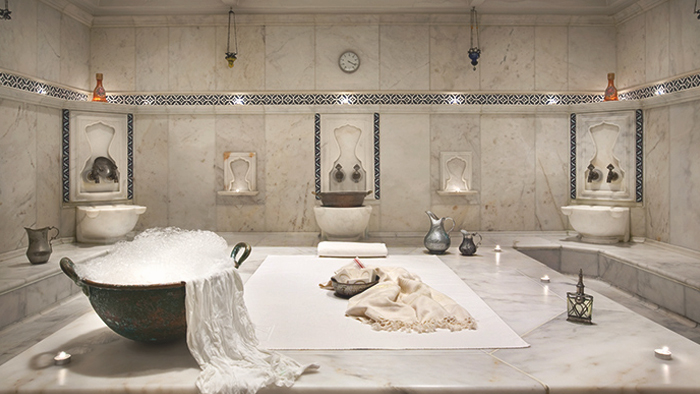
25 Mar A Sacred and Sweaty Turkish Ritual
The hammam has been the site of a purifying and beautifying ritual spanning thousands of years. As a timeless tradition, it uses the most basic of nature’s gifts – water, heat and a sponge, and is a perfect solution to counter some of the more stressful moments from modern life.
There are countless therapeutic and beautifying qualities to the hammam ritual. First of all, the steam dilates your pores, thereby purifying your body from harmful toxins. The kese scrub not only deeply cleanses your skin, improving its tone and texture, but also increases blood circulation and strengthens your immune system. The heat from the hammam also relaxes your muscles and relieves those suffering from joint pain and inflammation. If you suffer from allergies and asthma, the heat also dilates your lung’s passageways and facilitates breathing. Ibn Sina, the Islamic prince of physicians, had even recommended a visit to the hammam to treat paralysis, nervous disorders, digestive problems, kidney and liver malfunctioning and obesity among other conditions.
Particularly with the start of spring, if you find yourself in the vicinity of an authentic hammam, why not head over for a rejuvenating physical and emotional detox.
The hammam ritual takes place in three-interconnected chambers; starting off with the Camekan, later with the Ilıklık and lastly with the Hararet/Sıcaklık.
The Camekan
The first step in the hammam ritual involves undressing in the Camekan. In traditional hammams, the Camekan had been divided into small private chambers, where each bather could undress and rest following the ritual. Here, you will be given a peştamal, (a traditional towel which dries very quickly), to wrap yourself with for the entire bathing process, as well as nalın, wooden clogs, in order to avoid slipping on the marble floors. You should also remember to drink plenty of water before beginning the ritual!
The Ilıklık
The next step involves moving over to the Ilıklık, the “warming room”. As a transitory room, the humid nature of the Ilıklık allows one to adjust their body temperature before entering the hottest part of the ritual. Here, you can rest and gradually begin to raise your body temperature in preparation for the journey.
The Hararet/Sıcaklık
The third step involves moving over to the Hararet/Sıcaklık, the hot and steamy room. It is usually designed so that the rays of light filtered from a high central dome illuminate the steam and create an otherworldly feeling. Here, the basic idea is to perspire so that your pores open up, which will loosen the dirt in preparation for your wash. You can do this by lounging on the heated marble göbektaşı, the “belly stone”, or by sitting down by one of the kurnas, marble wash basins by the walls, filling your tas, copper bathing bowl, at the basin with hot spring water and tipping it over your head and body. The water contains sulfur and salt, which is beneficial for the treatment of rheumatic and skin diseases as well as nervous breakdowns. Using a pumice stone, you can also rub the soles of your feet. In the most general sense, a person sweats approximately 1.5 litres within 15 minutes in the hammam. Sweating to this extent helps activate the kidneys and toxins constitute approximately 10 percent of the sweat thrown in this way. By opening the pores of the skin, it is also frequently used in the treatment of cellulite.
Once you have perspired a considerable amount, using a kese, a rough mitten, you may begin to scrub every inch of your body, or if you prefer, have a natir, an attendant, help you. Although exfoliating with the kese might feel intense or relaxing, or perhaps both, the health benefits are numerous. By scrubbing away the dead layers of your skin, your pores are left open, gushing away harmful toxins. Kese scrubbing also increases circulation to the surface of your skin, kick-starting new skin cell production.
The next step is a foam massage with traditional olive soap, rich in vitamins E and C. Your attendant may use a lacy cloth, similar to an icing bag, to create a rich lather that feels incredibly soothing. The massage ensures real relaxation and sense of purity. It also squeezes out bloat, reduces cellulite and eases tense muscles.
After you are washed up, you can finally move over to the Camekan, in order to relax, rest, dry off and allow your body to return to its regular temperature. You should also re-hydrate yourself. At this point, your skin will now be glowing rosily and will feel as soft and nourished as a baby’s skin.
Caution: If you are a cardiac patient or suffer from blood pressure problems, you should consult a doctor before going to a hammam.
